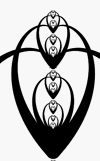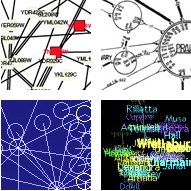Dear readers,
I have turned on commenting again. To combat spam I have installed a plug-in that will ask you to answer a simple math challenge (as in “add 3 and 8”). Please try it out and e-mail me if it doesn’t work.
Geoffrey Rockwell
Dear readers,
I have turned on commenting again. To combat spam I have installed a plug-in that will ask you to answer a simple math challenge (as in “add 3 and 8”). Please try it out and e-mail me if it doesn’t work.
Geoffrey Rockwell
 mandalabrot.net is the home of kiddphunk (Ian Timourian) and his visualizations, experiments and remixes. He has a number of Context Free Design Grammar experiments. Timourian also has a photo kiddphunk site with an doubled way of showing images.
mandalabrot.net is the home of kiddphunk (Ian Timourian) and his visualizations, experiments and remixes. He has a number of Context Free Design Grammar experiments. Timourian also has a photo kiddphunk site with an doubled way of showing images.
Thanks to Johnny R. for pointing me to this collection of “Explorations of Generative Art, Mathematics, Algorithmic Design and the Beauty of Life / Vol 1”.

VisualComplexity.com intends to be a unified resource space for anyone interested in the visualization of complex networks. The project’s main goal is to leverage a critical understanding of different visualization methods, across a series of disciplines, as diverse as Biology, Social Networks or the World Wide Web. I truly hope this space can inspire, motivate and enlighten any person doing research on this field. (From the About page.)
I discovered this through the del.icio.us.discover project. We need a comparable collection of text visualization projects.
The Research and Development Unit for English Studies (RDUES) of UCE of Birmingham has a tool WebCorp: The Web as Corpus which searches google for a term and then goes to the top 199 documents Google identifies and searches them. It takes a while and works like our Googlizer, but produces more verbose results. It produces a concordance organized by document with links to a full word frequency list for the doc. The advanced search form has some interesting features, including the ability to point it at other engines.
UCE Birmingham is strange place from the web. UCE stands for “University of Central England” and you have to go deep to the At A Glance : History Of UCE Birmingham to find this out. (There’s no point explaining it to outsiders anywhere on the web page.) They seem to have been formed out of all the little colleges, polytechnics and schools in the area in 1992.
The University of Essex has a site on linguistics corpora with an interesting W3Corpora Search Engine. The Search Engine has a wizard approach where you make choices and continue to next section. It works on Guternberg texts. They also have a tutorial on corpus linguistics.
 The Variable Media Network is joint project by the Guggenheim Museum and the Daniel Langlois Foundation to look at models for preserving “performance, conceptual art, installations and, of course, artwork incorporating technological elements or relying on structures or networks that are themselves very unstable.” The project has online case studies and has published a edited book, Permanence Through Change.
The Variable Media Network is joint project by the Guggenheim Museum and the Daniel Langlois Foundation to look at models for preserving “performance, conceptual art, installations and, of course, artwork incorporating technological elements or relying on structures or networks that are themselves very unstable.” The project has online case studies and has published a edited book, Permanence Through Change.
This concept (variable media) suggests considering the description of works independently of the media used to create them. Rather than list a work’s physical components, the variable media approach is to understand the work’s behavioural characteristics and intrinsic effects. (Variable Media Concept as developed by Jon Ippolito, quoted on Fondation Daniel Langlois page.)
The idea if preserving variation and behaviour instead of stable media makes sense as a strategy for documenting interactive works, even beyond new media art, like computer games and electronic literature.
 net.flag is an interactive work of net art which lets you manipulate a flag for the internet. You can see what other did to the flag and change components. The work gets you thinking about what sort of territory the net is.
net.flag is an interactive work of net art which lets you manipulate a flag for the internet. You can see what other did to the flag and change components. The work gets you thinking about what sort of territory the net is.

One of my favorite conceptual art groups, General Idea has a web site. General Idea was a Toronto based collaborative of three artists who put together installations, performances, boutiques, and manifestos. From ARTFORUM on FILE MEGAZINE:
the three began working under another signature rubric, “Miss General Idea.” A 1971 altered photograph, which they called their “artist’s conception,” figures her as a transvestite, rubber-outfitted version of Hugo Ball at Cabaret Voltaire. Miss General Idea functioned as the group’s muse, and General Idea hosted a series of Miss General Idea beauty pageants that set out in countercultural fashion “to (capture) glamour without falling into it.” (Art in America, March 2005)
Two of the three have since died, only AA Bronson is still alive and working.
The “Digital Art Museum has an ambitious aim – to be the source for history on the digital arts. They have an interesting set of essay links and information about the early history of digital arts.
Digital Art Museum aims to become the world’s leading online resource for the history and practice of digital fine art.
It exhibits the work of leading Artists in this field since 1956. [DAM] is an on-line museum with a comprehensive exhibition of Digital Art supported by a wide range of background information including biographies, articles, a bibliography and interviews.
 lecielestbleu.com has an amazing collection of Flash puppets, musical toys, and interactive art toys online. It includes a music piping toy, P?¢te ?† Son where you pipe a flow of baubles that make music when they hit devices. They also have an amazing Puppet Tool where you can animate a puppet of a horse, or other being.
lecielestbleu.com has an amazing collection of Flash puppets, musical toys, and interactive art toys online. It includes a music piping toy, P?¢te ?† Son where you pipe a flow of baubles that make music when they hit devices. They also have an amazing Puppet Tool where you can animate a puppet of a horse, or other being.